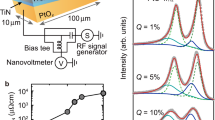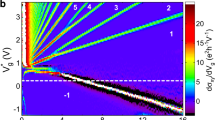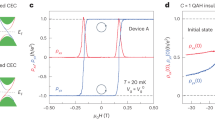Abstract
The prediction and experimental verification of the quantum spin Hall state marked the discovery of a new state of matter now known as topological insulators. Two-dimensional topological insulators exhibit the quantum spin-Hall effect, characterized by gapless spin-polarized counter-propagating edge channels. Whereas the helical character of these edge channels is now well established, experimental confirmation that the transport in the edge channels is spin polarized is still outstanding. We report experiments on nanostructures fabricated from HgTe quantum wells with an inverted band structure, in which a split gate technique allows us to combine both quantum spin Hall and metallic spin Hall transport in a single device. In these devices, the quantum spin Hall effect can be used as a spin current injector and detector for the metallic spin Hall effect, and vice versa, allowing for an all-electrical detection of spin polarization.
This is a preview of subscription content, access via your institution
Access options
Subscribe to this journal
Receive 12 print issues and online access
$209.00 per year
only $17.42 per issue
Buy this article
- Purchase on Springer Link
- Instant access to full article PDF
Prices may be subject to local taxes which are calculated during checkout





Similar content being viewed by others
References
Bernevig, B. A., Hughes, T. L. & Zhang, S. C. Quantum spin Hall effect and topological phase transition in HgTe quantum wells. Science 314, 1757–1761 (2006).
König, M. et al. Quantum spin Hall insulator state in HgTe quantum wells. Science 318, 766–770 (2007).
König, M. et al. The quantum spin Hall effect: Theory and experiment. J. Phys. Soc. Jpn 77, 031007 (2008).
Kane, C. L. & Mele, E. J. Quantum spin Hall effect in graphene. Phys. Rev. Lett. 95, 226801 (2005).
Bernevig, B. A. & Zhang, S. C. Quantum spin Hall effect. Phys. Rev. Lett. 96, 106802 (2006).
Wu, C. J., Bernevig, B. A. & Zhang, S. C. Helical liquid and the edge of quantum spin Hall systems. Phys. Rev. Lett. 96, 106401 (2006).
Xu, C. & Moore, J. Stability of the quantum spin Hall effect: Effects of interactions, disorder, and topology. Phys. Rev. B 73, 045322 (2006).
Maciejko, J. et al. Kondo effect in the helical edge liquid of the quantum spin Hall state. Phys. Rev. Lett. 102, 256803 (2009).
Roth, A. et al. Nonlocal transport in the quantum spin Hall state. Science 325, 294–297 (2009).
Büttiker, M. Edge-state physics without magnetic fields. Science 325, 278–279 (2009).
Hankiewicz, E. M., Molenkamp, L. W., Jungwirth, T. & Sinova, J. Manifestation of the spin Hall effect through charge-transport in the mesoscopic regime. Phys. Rev. B 70, 241301 (2004).
Valenzuela, S. O. & Tinkham, M. Direct electronic measurement of the spin Hall effect. Nature 442, 176–179 (2006).
Brüne, C. et al. Evidence for the ballistic intrinsic spin Hall effect in HgTe nanostructures. Nature Phys. 6, 448–454 (2010).
Rothe, D. G. et al. Fingerprint of different spin-orbit terms for spin transport in HgTe quantum wells. New J. Phys. 12, 065012 (2010).
Novik, E. G. et al. Band structure of semimagnetic Hg1−yMnyTe quantum wells. Phys. Rev. B 72, 035321 (2005).
Hinz, J. et al. control of the giant Rashba effect in HgTe quantum wells. Semicond. Sci. Technol. 21, 501–506 (2006).
Büttiker, M. Four-terminal phase-coherent conductance. Phys. Rev. Lett. 57, 1761–1764 (1986).
Büttiker, M. Symmetry of electrical conduction. IBM J. Res. Dev. 32, 317–334 (1988).
Beenakker, C. W. J. & van Houten, H. Billiard model of a ballistic multiprobe conductor. Phys. Rev. Lett. 63, 1857–1860 (1989).
Sundaram, G. & Niu, Q. Wavepacket dynamics in slowly perturbed crystals: Gradient corrections and Berry-phase effects. Phys. Rev. B 59, 14915–14925 (1999).
Acknowledgements
We thank M. Leberecht and R. Rommel for assistance in some of the experiments andE. G. Novik for discussions of the band structure. We gratefully acknowledge financial support by the Deutsche Forschungsgemeinschaft (Schwerpunkt Spintronik) under grants HA 5893/1-2 (E.M.H.) and BU 1113/3-1 (H.B.), the German-Israeli Foundation (I-881-138.7/2005) the DFG-JST joint research project Topological Electronics, the National Science and Engineering Research Council (NSERC) of Canada and the Stanford Graduate Fellowship Program (SGF). S-C.Z. is supported by the Department of Energy, Office of Basic Energy Sciences, Division of Materials Sciences and Engineering, under contract DE-AC02-76SF00515 and by the Keck Foundation. We agree the Leibniz Rechenzentrum Munich, the facilities of the Shared Hierarchical Academic Research Computing Network (www.sharcnet.ca) and the computing cluster of the Stanford Institute for Materials and Energy Science at the SLAC National Accelerator Laboratory for providing computer resources.
Author information
Authors and Affiliations
Contributions
C.B., A.R., H.B. and L.W.M. have contributed to the experiments, E.M.H., J.M., X-L.Q. and S-C.Z. contributed to the theory. All authors have participated in the interpretation of the experiments. The paper was written by C.B., J.M., E.M.H., S-C.Z and L.W.M., and the Supplementary Information by J.M., X.L.Q. and E.M.H.
Corresponding author
Ethics declarations
Competing interests
The authors declare no competing financial interests.
Supplementary information
Supplementary Information
Supplementary Information (PDF 2033 kb)
Rights and permissions
About this article
Cite this article
Brüne, C., Roth, A., Buhmann, H. et al. Spin polarization of the quantum spin Hall edge states. Nature Phys 8, 485–490 (2012). https://doi.org/10.1038/nphys2322
Received:
Accepted:
Published:
Issue Date:
DOI: https://doi.org/10.1038/nphys2322
This article is cited by
-
Supercurrent mediated by helical edge modes in bilayer graphene
Nature Communications (2024)
-
Revealing the topological phase diagram of ZrTe5 using the complex strain fields of microbubbles
npj Computational Materials (2022)
-
Interacting topological edge channels
Nature Physics (2020)
-
Room-temperature quantum spin Hall phase in laser-patterned few-layer 1T′- MoS2
Communications Materials (2020)
-
Coherent spin transport through helical edge states of topological insulator
npj Computational Materials (2020)



